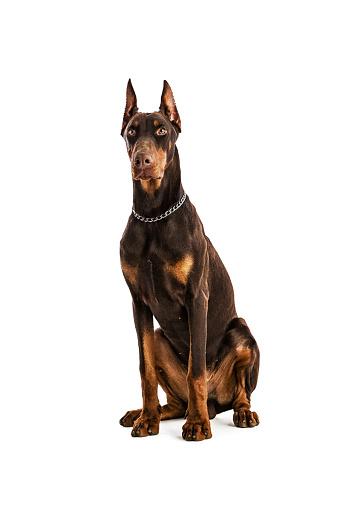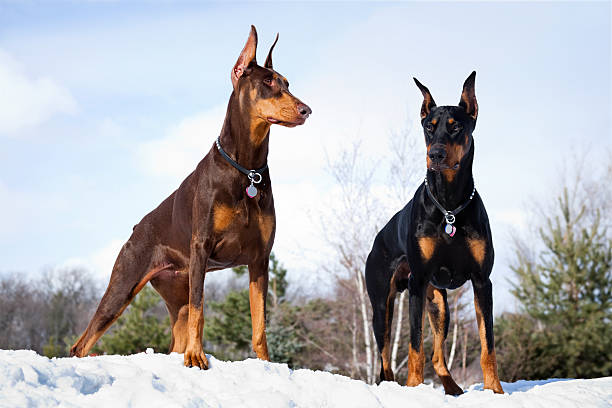By Velvet K9
What breeds created the Doberman?
In 1900 the Doberman Pinscher became official.The Doberman Pinscher origins are believed but not proven, to be bred from the Rottweiler, the old Short Haired Shepherd – Dog, Black and Tan Terrier and Smooth – German Pinscher. When canines are DNA tested they are called the Doberman Pinscher. Reading 100% Doberman Pinscher. The breed is only recognized by that name so the breeds that were used are not shown due to the time in-between the first breeding while becoming its own. So it is unknown how this magnificent dog was created.
How was the Doberman Pinscher developed?
Alpoda Germany was the breed’s location. Developed by Karl Friedrich Louis Dobermann in the 1860’s. He needed a dog fearless, willing to defend from attackers and their dogs, intimidating with a large build. Obedience and instant restraint was also bred into their bloodline. Karl Dobermann was the keeper of a dog pound.This allowed him a wider selection of the best dogs for the job. Originally they were tailored to the needs of a tax collector. Due to the issues of violence and hate crimes targeted towards this type of work.
AKC Structure Standards
AKC expects the appearance to be elegant, proud, muscular, compact in build, carrying great speed and endurance.
Height Withers: 26 to 28.
Head – Widens slowly to ears in an even line.
Eyes – Almond shaped healthy appearance. Darkest shades preferred.
Ears – Carried erect. Cropped if used for show.Top of skull lined up with ears.
Skull – Flat with the slightest turn to stop at muzzles Bridge.
Muzzle – Extending line parallel with top of skull. Flat muscular cheeks. Nose color varies with coat color. Lips close to Jaws. Jaws powerful and full, filled very well beneath the eyes. Strong developed white teeth. 42 naturally placed scissor shaped. 20 teeth on upper jaw, 22 teeth on bottom jaw.
Neck, Topline, Body:
Neck- carried proud, dry muscled, arched well. Nape of the neck should slowly widen. Neck proportioned with body and head. Pronounced withers. Back firm, short and sufficiently wide. Muscular lions, straight line of withers to a round croup. Broad chest with defining forecast. Sprung ribs showing from spine, yet flat in lower end for clearance in elbow. Elbow brisket deep. Belly tucked. A curve should show between belly and brisket. Broad proportioned hips. Hips matching body breadth at the ribs and shoulders.
Tail – At the second joint docked, aligned with the spine. Mild horizontal lift while the dog is alert.
Forequarters – 45 – degree angle toward ground along with a uniting of upper arm 90 degree angle. Equal in length. Legs straight and parallel to each other, at the elbow to pastern. Pastern heavy boned and muscular. While posed in a regular stance elbows should lie closely to the brisket. Dewclaws for show can be removed. Being perpendicular to the ground while firm. Dogs’ feet are compact, arched and cat-like with no turning in or out.
Hindquarters – Angulated Hindquarters must balance forequarters. 30 degree angle reach of hip bone falling from spinal column mildly rounded.With a filled croup.The upper shanks must show right angles toward hip bones which are wide, well muscled, long and both thighs must have defined stifles. Being upper and lower equal in length. Hock to heel perpendicular to ground when resting. Straight legs from rear. Parallel demonstrating room between for a fit body.

FCI Standards
Europe has a different approach though similar in physical traits. In their system one parent of the litter must prove character by passing a test. A doberman must be energetic, alert, fearless, watchful and determined. European lines will be fiercely loyal to their families and handlers. Not to strangers. At times resulting in biting new handlers and judges.Though show ring dogs can be trained with more effort. Europe stopped using the word Pinscher which means terrier cutting it to Doberman. America still uses the original name. American Doberman Pinschers bred the working line out to create family dogs that are less aggressive.They wanted a refined look. So their lines are slimmer, more elegant, smaller boned, with less muscle, longer necks and smaller feet. Which would become more manageable and great for the novice.


More Stories
5 Reasons Why Everyone Should Look Forward to Save Earth Mission’s Takeoff Event
Save Earth Mission’s Takeoff Event Countdown Starts: Get Ready to Witness History
Saudi Stable’s Triumphs Abroad: Fahd Al-Sayari’s Journey of Success in International Horse Racing